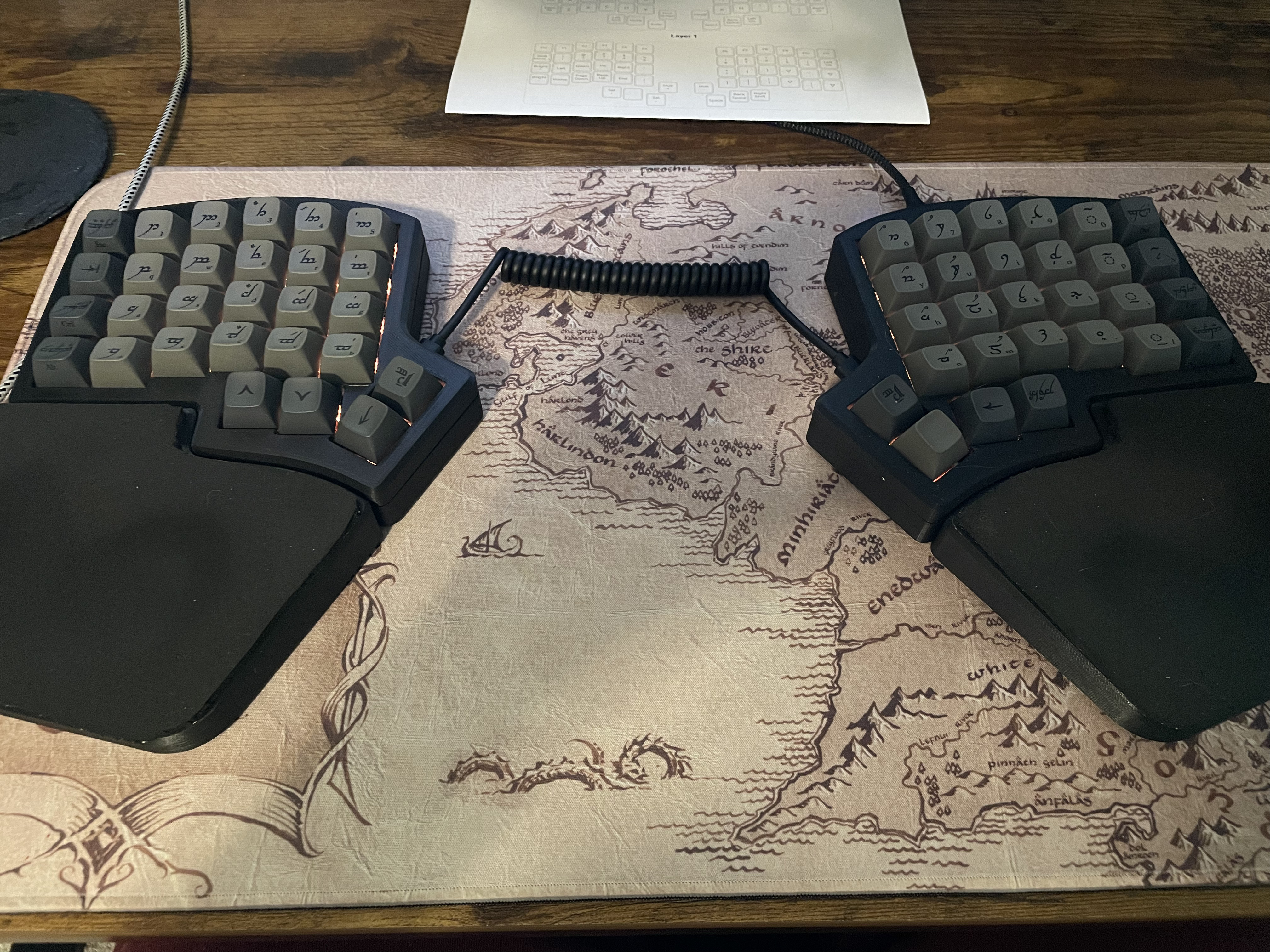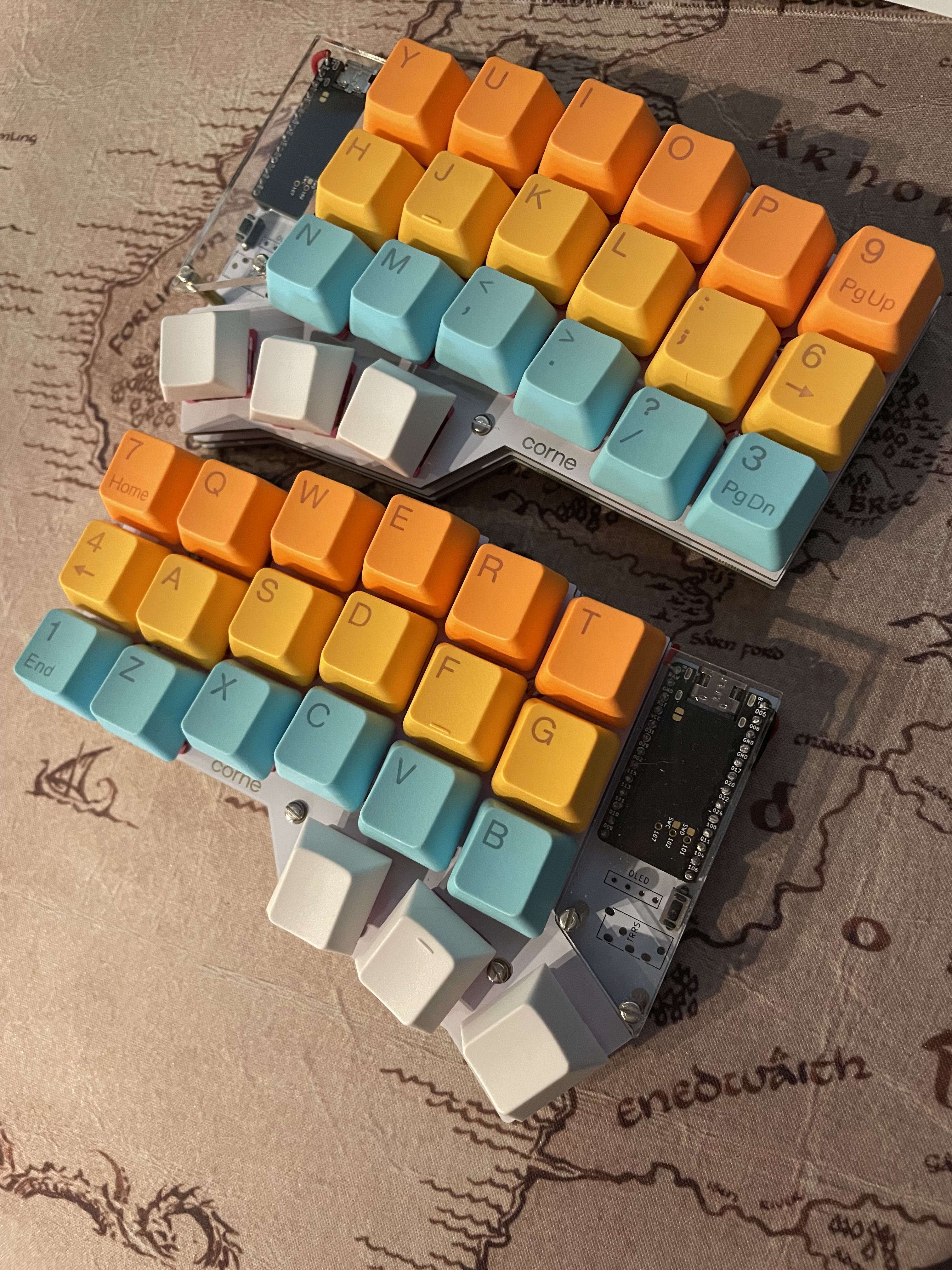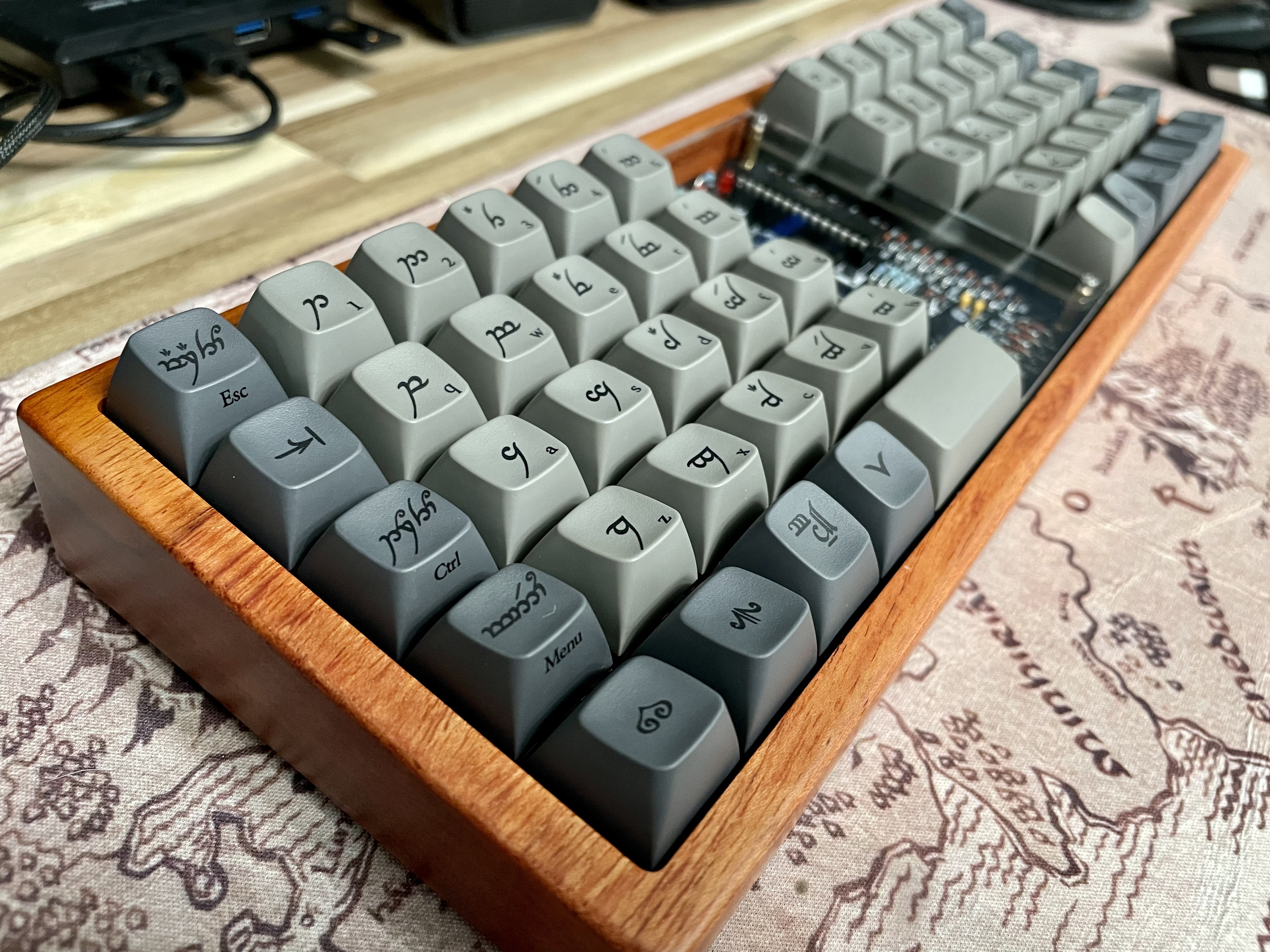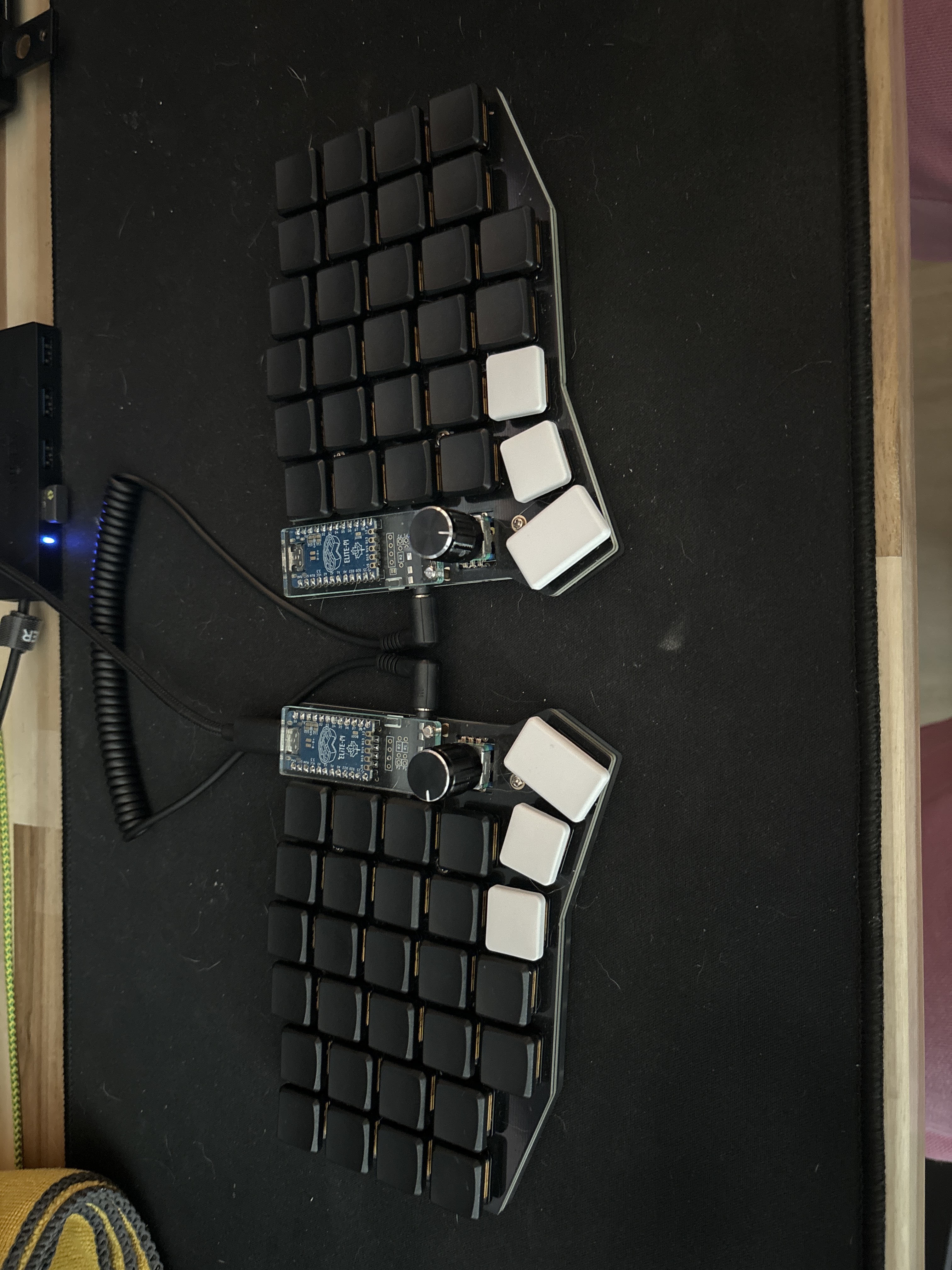I’ve been using ergonomic keyboards for almost exactly a year now. It started out of curiosity and has turned into a full blown hobby. Over the past year I ordered 4 different ergonomic keyboards. 3 of which I had to solder and flash. I learned to touch type and have been using colemak (mod DH) since I started. I went from typing 110 WPM on qwerty with what I call “gaming form” to about 100 WPM on colemak with proper form. This might sound like a downgrade, but I can now type for hours without any pain, and I can type MUCH faster when it comes to writing code. I’ve also learned a lot about the keyboard community and have thoroughly enjoyed the ability to adapt my keymap to my needs.
The keyboards I’ve bought/built so far are:
- Keebio Iris
- Corne (42 key, fully wireless)
- Lumberjack (my favorite for looks)
- Sofle v2 choc (my current daily driver, favorite for typing)
I’d like to just capture some of my thoughts on each of these keyboards and what led me to each of them.
Keebio Iris

The Iris was my first split keyboard. I had been using a pretty standard mechanical keyboard for 5 years or so prior to this (TKL). I never really had any issues with it, but I stumbled upon the ergo community and was intrigued. I decided to order the Iris because I didn’t trust myself to assemble a kit yet. I was also interested in the hotswap sockets. I ordered the kit with the Durock Sunflower switches (Tactile) and some DSA keycaps from Amazon. I was pretty excited when it arrived and I got to work putting it together. I was able to get it assembled in less than 30 minutes and I was typing on it shortly after.
Initial Learning Curve
I immediately noticed that this was going to be a rough ride. I had to look down at the keyboard to type anything. I was typing at about 20 WPM and it was very frustrating. Since I was already having such a hard time, and I didn’t want to bring any of my bad habits from QWERTY over, I started researching alternative layouts. I had heard of Dvorak before, but my research led me to believe that there are newer layouts that are better. Eventually, I was deciding between Workman and Colemak Mod DH. I decided to go with Colemak because it seemed to be the most popular and therefore had the most resources available. It helped that most metrics I saw showed Colemak as being slightly faster than Workman. I also decided to go with Mod DH because many people felt it is more comfortable, at least on split columnar keyboards.
Learning to touch type Colemak Mod DH
I started out by using keybr.com to learn the layout. This site is an amazing resource for learning to touch type. It has a very nice UI and it’s free. I used this site for about 2 months, until I had comfortably progressed through all of the keys. I was typing at about 40 WPM at this point. I then switched to monkeytype.com simply because it has a nicer UI and I liked the stats it provided.
I would highly recommend switching to an alternative layout if you’re going to use an ergonomic keyboard. It’s a great opportunity to learn to touch type and it actually makes switching to standard keyboards easier (for example when traveling and using a laptop). The context switch from an ergo split on Colemak to a standard keyboard on QWERTY is much easier than switching from an ergo split on QWERTY to a standard keyboard on QWERTY. I have to admit that my QWERTY skills have suffered a bit, but I can still type at about 80 WPM on QWERTY. I’m sure that number would go up if I was on a standard keyboard for a few days.
Summary
The Iris was a great first ergo keyboard. It was large enough that I didn’t have to cram too many keys onto alternate layers, but small enough that I could still reach all of the keys. I used it many times for gaming and it worked great. I would find myself revisiting it every now and then just to see how I felt about it. I used it for about 3 months before I decided to try something else. I was typing at about 50 WPM on it and I was very comfortable with the layout.
Corne

After using the Iris for a little over 3 months, I decided I wanted to try a smaller keyboard. It felt that touch typing the number row was a bit awkward on the Iris, and I saw many people in the community using 36 and 42 key keyboards. I decided to go with the Corne because it was incredibly popular, looks great, and I can get it fully wireless. I ordered the kit from Little Keyboards and got to work.
The switches I went with were Boba U4Tx (Half-Silent Tactile) and I went with the XDA keycaps this time.
I hadn’t soldered anything since I was in high school (different story, but I used to build chat adapters for Xbox 360 headsets to work on Xbox One using the standard Xbox One headsets). I was a bit nervous, but I had watched a few videos and gone over the documentation a few times. I was able to get it soldered in about 4 hours. I was pretty proud of myself. Because I chose to go with the wireless version, I had a hard time finding documentation for that part of the build. I wish I had taken more notes, but I was able to get it working great.
I used Nice!Nanos for the microcontrollers and flashed them with ZMK. I had heard many good things about home row mods, so I decided to try them out. The Miryoku keymap was a great starting point for me. I was able to get it flashed and working in about 2 hours. I was typing on it shortly after.
I gave the home row mods a try for about 2 weeks. I really liked the idea of them, but I found that I was making more mistakes than I was on the Iris. I also found that I was having to think about the mods more than I wanted to. I decided to stop using them and take advantage of the extra pinky keys.
Midway through my time with the Corne, I decided to try using my old OEM profile keycaps from my original mechanical keyboard. I was surprised to find that I actually liked them better than the DSA/XDA keycaps. I think this is because I was able to feel the edges of the keys better and honestly probably just years of muscle memory.
It was with the Corne that I really started to hit my stride with split keyboards. I was typing at about 80 WPM at this point (5 months in), and had been using splits full-time since getting the Corne. I was starting to develop my own custom layout and began tailoring it to my workflow.
Summary
I really enjoyed the Corne. It was a great keyboard and I loved the wireless aspect. I used it for about 2 months before I decided to try something else. I was typing at about 80 WPM on it and I was very comfortable with the layout.
Lumberjack

The Lumberjack was one I was eyeing for months before I jumped on a group buy. I was really attracted to the look of it. Coming from the Corne, I was excited to have a number row again. I went all out on this one and made it (in my opinion) look amazing. I went with a wood case and some Lord of the Rings themed MT3 keycaps from Drop. For the switches, I went with the Boba U4Ts.
Soldering this kit was a bit more difficult than the Corne. It is completely through-hole, so there are a lot more components to solder. I was able to get it soldered in about 6 hours. Somehow, I managed to get it working on the first try.
I love this keyboard. It’s my favorite for looks. I used it as my daily driver for about 5 months. I got my max typing speed on this keyboard (115WPM). I was very comfortable with the layout and had fine-tuned my custom keymap. I was using it for gaming and typing.
My only gripe with this keyboard is the thumb cluster. There are only 2 keys on each side that my thumbs can comfortably reach. I’m most comfortable with 3 thumb keys on each side. I was able to make it work, but I was always thinking about how I could make it better.
Sofle v2 choc

My decision to buy the Sofle was a bit strange. I don’t really intend to use it in the long term. I bought it because I wanted to try out the choc switches. I had heard good things about them and I wanted to see if I liked them better than MX style switches. Ultimately, I would like to get a keyboard with a keywell, either the Kinesis Advantage 360 (MX style switches) or the Glove80. But without knowing if I would like the choc switches, I didn’t want to spend the money on either of those keyboards.
I bought the kit from Little Keyboards and went with the Kailh Choc Whites.
I’m pretty comfortable soldering at this point, so I was able to get it soldered in about 3 hours. I got it flashed with QMK and got to typing.
The choc whites were not my cup of tea. I found the activation point to be inconsistent with the clicks, and I didn’t like the feel of the click. After a week, I had already ordered some Sunset Switches (Tactile). Those arrived after another week and I swapped them out. I like these switches soooo much better. They are very smooth and the bump is very nice. I’m not sure if I like them better than the Boba U4Ts, but they are definitely in contention.
The thumb cluster on this keyboard is my favorite so far. It has 3 easily reachable keys on each side.
I’ve been using this keyboard for 2 months now and I’m very comfortable with it. I’m typing at about 100 WPM on it. I’m still using my custom keymap, and I’ve gotten so much omre productive than I was a year ago.
Conclusion
I’m very happy with my decision to try out ergonomic keyboards. I’m finally touch typing and I’m typing faster than I ever have. I’m also much more comfortable when typing. I don’t think I’ll ever go back to a standard keyboard.
My next keyboard will probably be the Glove80. I’m very interested in trying out a keywell and I have started to really like the choc switches. I will probably go with the Sunset Switches (Tactile) again.
I hope you can excuse my rambling. I just wanted to get my thoughts down. I intend to follow this up with more tailored posts about different aspects of my keyboard journey. I’m thinking about doing a post on my custom keymap, and maybe a post about my desktop environment/ tmux/nvim setup.